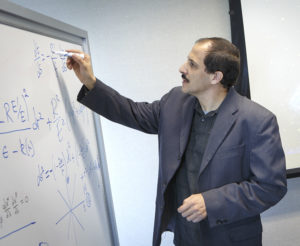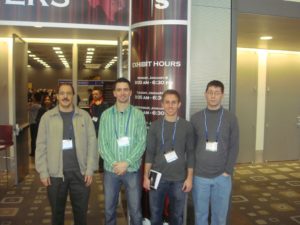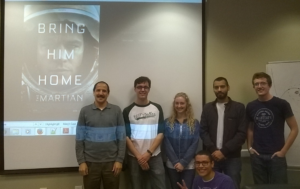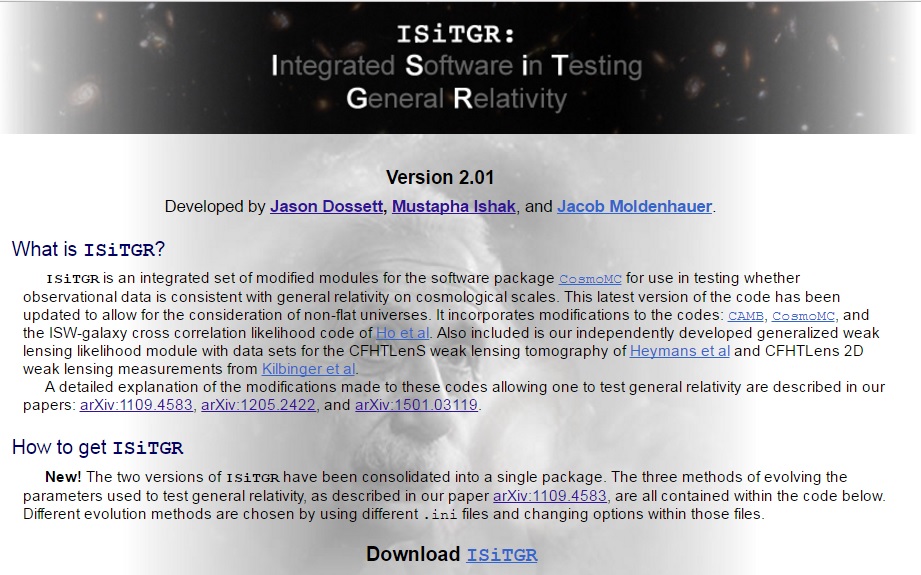Education

Ph.D. in Cosmology and General Relativity at Queen’s University at Kingston, Canada.
Research Associate in Cosmology at Princeton University, New Jersey, USA
For my Curriculum Vitae: Mustapha Ishak CV May 2018
Professional recognitions and honors
Journal Paper voted by the Editorial Board of Classical and Quantum Gravity Journal as one of the journal’s highlights of 2002. Article title: Interactive Geometric Database, Including Exact Solutions of Einstein’s Field Equations, Mustapha Ishak and Kayll Lake, Classical and Quantum Gravity 19, 505 (2002).
2002-2004 Postdoctoral Fellowship for Excellence in Research and Leadership from the Natural Sciences and Engineering Research Council of Canada (NSERC)
Journal paper selected by Chief Editor Gerardus ‘t Hooft (Nobel Laureate in Physics 1999) to appear in the highlights of 2008 of the Foundation of Physics Journal. Article title: Remarks on the formulation of the cosmological constant/dark energy questions. Mustapha Ishak. Foundation of physics Journal, 37:1470-1498,2007.
2007 Award for Outstanding Teacher of the Year from the School of Natural Sciences and Mathematics. University of Texas at Dallas
Journal paper highlighted at Physical Review Letters as Editors’ suggestion and selected for a synopsis in Spotlighting Exceptional Research in Physics website of the American Physical Society. “Stringent Restriction from the Growth of Large-Scale Structure on Apparent Acceleration in Inhomogeneous Cosmological Models”, Mustapha Ishak, Austin Peel, and M. A. Troxel. Phys. Rev. Lett. 111, 251302 (2013).
2013 Robert S. Hyer Award for Excellence in Research from the Texas Section of the American Physics Society. Jointly with Michael Troxel.
2018 Award for Outstanding Teacher of the Year from the School of Natural Sciences and Mathematics. University of Texas at Dallas
Biosketch
I am a theoretical astrophysicist. My recent research projects and interests are in Physical Cosmology, Gravitational Lensing, and General Relativity (see next section). I am involved in theoretical, numerical, and data-related projects. I am a full member of the LSST Dark Energy Science Collaboration (DESC) working mainly within the Theory-Joint-Probes (TJP) and the Weak Lensing (WL) groups.
I completed my Ph.D. in 2002 in Cosmology and General Relativity with Prof. Kayll Lake at the Physics Department at Queen’s University at Kingston in Canada. My graduate work included investigations in inhomogeneous cosmological models; an inverse approach to Einstein’s equations; oscillation modes in compact astrophysical objects; and matching spacetimes using junction conditions.
Then, I joined the Physics Department at Princeton University as a postdoctoral fellow where I worked on projects in cosmology, cosmic acceleration and gravitational lensing with Prof. Steinhardt, Prof. Seljak, and other researchers. After that, I worked as a Research Associate at the Astrophysical Sciences Department at Princeton in collaboration with Prof. Spergel and other researchers on cosmic acceleration and testing gravity at cosmological scales. While there, I organized the Princeton & IAS Gravitational Lensing Seminar and taught (preceptor with lecturer appointments) at the Physics Department (Physics 103) and the Astrophysics Department (Astro 203).
In 2005, I started a professorship position at the Department of Physics at the University of Texas at Dallas (UT Dallas). I discovered that a real thirst for Cosmology and Astrophysics exists within the students at UT Dallas and also the general public in the Dallas Metroplex Area, so I launched a number of initiatives and activities in response to that. I formed the new Cosmology, Astrophysics and Relativity Group at UT Dallas.
For a partial list of my papers at NASA ADS server click here.
For a partial list of my papers at INSPIRE HEP server click here.
With students, we developed a software package called ISiTGR (Integrated Software in Testing General Relativity) that is an integrated set of modified modules for the software package CosmoMC for use in testing whether observational data is consistent with general relativity on cosmological scales. Click here for ISiTGR webpage.
I very much enjoy classroom teaching and mentoring students. The courses I taught at UT-Dallas include PHYS2325 Mechanics, PHYS3312 Classical Mechanics, PHYS4V89 Cosmology, PHYS5303 Math Methods for Physics III (Graduate Course), PHYS5395 Cosmology (Graduate Course), PHYS5311 Classical Mechanics (Graduate Course), PHYS5391 Special Relativity (Graduate Course), and PHYS5392 General Relativity (Graduate Course). I received the 2007 and 2018 Outstanding Teaching Awards from the School of Natural Sciences and Mathematics at UTD.
My research work received funding from by NASA, DOE, NSF, private foundations and corporate sector.
I served as proposal reviewer for NSF, NASA, the Research Foundation of Canada, CONICYT Chile, The Foundation of Polish Science, and the Texas Space Grant Consortium. I served as referee for Physical Review Letters, Physical Review D, Astronomy & Astrophysics, Classical and Quantum Gravity, Monthly Notices of Royal Astronomy Society, General Relativity and Gravitation, Euro-Physics Letters and Physics Letters B. I have been member of UTDallas senate for 9 years and participated or chaired over 10 university or school committees. I chaired (jointly with Prof. Wolfgang Rindler) the local and scientific organizing committees of the 27th Texas Symposium on Relativistic Astrophysics. The symposium received 470 participants, over 300 talks in 49 parallel sessions; 24 plenary and review talks, and a public lecture attended by over 1300 people.
I organize and look after the activities and expansions of the new Cosmology, Astrophysics and Relativity Group at UT Dallas.
Doctoral Genealogy
Mustapha Ishak – Kayll W. Lake – Robert C. Roeder – George C. McVittie – Arthur S. Eddington
(Credit for reconstructing this genealogy goes to Prof. Kayll Lake)
Research Interests
-
 The origin/cause of the acceleration of the expansion of the Universe: Cosmological Constant, Dark Energy, Extensions to General Relativity.
The origin/cause of the acceleration of the expansion of the Universe: Cosmological Constant, Dark Energy, Extensions to General Relativity.- Testing Dark Energy versus Modified Gravity at Cosmological Scales of Distance. Software we developped for this..
- Gravitational Lensing and applications to cosmology. Intrinsic Alignments of Galaxies.
- Constraining cosmological parameters and cosmological models using probes such as gravitational lensing, the cosmic microwave background (CMB), and supernova searches.
- Inhomogeneous Cosmological Models and the averaging problem in cosmology
- Selected topics in General Relativity and Exact Solutions to Einstein’s Equations
- Projects at the intersection of modern cosmology and General Relativity
- Junction conditions for matching spacetimes and constructing wormholes and thin-shells
- Computer Algebra (symbolic computing) and application to cosmology and general relativity
Selected invited and plenary talk slides: (full list of talks available in CV)
Why is the Expansion of the Universe Accelerating? An overview. Colloquium talk given a number of times (14) about Dark Energy and Cosmic Acceleration. Click here for slides: Dark Energy Cosmic Acc Colloquium
Exact Solutions to Einstein’s Equations In Astrophysics. Plenary talk given at the Texas Symposium in Relativistic Astrophysics in Geneva (2015). Click here for slides: Exact Solutions In Astrophysics Ishak Final
Two Big Puzzles in Modern Cosmology. Public lecture given at Southern Methodist University (SMU) in Dallas (2015). Click here for slides: SMU EVENT 2015w
Constraints and tensions in Modified Gravity Parameters from Planck, CFHTLens and other data sets including Intrinsic Alignemnets Systematics. Invited talk presented at Testing Gravity Conference at Simon Fraser University (2015). Click here for slides: sfu2015
Why is the Expansion of the Universe Accelerating? Plenary talk given at the Texas Sections of the American Physical Society. Texas A&M at Commerce (2011). Click here for slides: APS 2011web
Constraints from Cosmological Data on Expansion and Growth of Structure in a Macroscopic Gravity Averaged Universe. Contributed talk given at the American Astronomical Society Meeting in San Diego (2016). Click here for slides: AAS San Diego 2016 Averaging
Current and previous students
Graduated Ph.D. Students:
James Richardson (graduated in 2008). Joined the corporate sector.
Jacob Moldenhaeur (graduated in 2010). Assistant Professor at University of Dallas.
Anthony Nwankwo (graduated in 2011). Joined the corporate sector.
Jason Dossett (graduated in 2013). Working as Research Fellow in Astrophysics at INAF — Osservatorio Astronomico di Brera, Italy.
Michael Troxel (graduated May 2014). Working as Research Associate in Astrophysics at The Ohio State University.
Austin Peel (graduated in May 2015). Working as Research Associate in Astrophysics and Cosmology at the Institute of Astrophysics, CEA-Saclay, France.
Tharake Wijenayake (graduated in in May 2016). Joined the corporate sector.
Current Ph.D. students:

Weikang Lin (graduation expected in 2017)
Yao Ji graduation expected in 2019)
Rahulkhumar Solanki (graduation expected in 2020)
Eske Pederson (graduation expected in 2021)
Masters students supervised:
Chris Allison
Jeffrey Scott
Brian Troup
Delilah Whittington
John Thompson
Lee Caps
Undergraduate student supervised:

Katherine Morgan (undergraduate Thesis/research, 2006)
Lee Isaac Trawick, (undergraduate Thesis/research, 2006)
Wendy Gartenberg, (undergraduate Thesis/research, 2007)
John Wilson (undergraduate Thesis/research, 2007)
Jason Dossett, (undergraduate Thesis/research, 2007, 2008)
Tan Lee, (undergraduate Thesis/research, 2008)
Austin Peel (undergraduate Thesis/research, 2007)
John Thompson (undergraduate Thesis/Research, 2008)
Lee Caps ((undergraduate Thesis/research, 20010)
Thomas Griffins (Undergraduate Research Project, 2012)
Nathan Newton (Undergraduate Research Project, 2012)
Jonathan Woodbury (undergraduate Thesis/research, 2013)
Victor Lee (Undergraduate Research Project, 2015)
Joseph Burnett (Undergraduate Thesis/Research, 2015)
Cristhian Quintero (Undergraduate research, 2016)

High-school students summer internships:
Tim Carlton summer 2006
Ray Whitside, summer 2007
Sid Mittal, summer 2008
Parker Maginley, summer 2008
Brandyn Lee, summer 2009
Scott Meesse, summer 2009
Genway Huang, summer 2010
Evan Remmele, summer 2011
Some news articles
Article by UT-Dallas News Services about the work: “Stringent Restriction from the Growth of Large-Scale Structure on Apparent Acceleration in Inhomogeneous Cosmological Models. , Mustapha Ishak, Austin Peel, M.A. Troxel, published in Physical Review Letters 111, (2013) 251302. (http://arxiv.org/abs/1307.0723). Paper was also highlighted at Physical Review Letters as Editors’ suggestion and selected for a synopsis in Spotlighting Exceptional Research in Physics website of the American Physical Society.
Faculty highlight article by UT-Dallas media services (2008).
Grants
PI, National Science Foundation, 2015-2018 (Research Project in Astrophysics and Gravitational Lensing)
PI, The John Templeton Foundation, 2014-2017 (Research Project in Cosmology)
PI, National Science Foundation, 2011-2014 (Research Project in Astrophysics and Gravitational Lensing)
PI, Department Of Energy, 2010-2013 (Research Project in Cosmology and Dark Energy)
PI, NASA Astrophysics Theory Program, 2009-2012 (Research Project in Cosmology and Cosmic Acceleration)
PI, Texas Space Grant Consortium, to start in 2008 (Research Project in Astrophysics and Cosmic Acceleration)
PI, From Corporate Sector, 2008 (Research Project I in Gravity & statistics)
PI, From Corporate Sector, 2009 (Research Project II in Gravity & statistics)
PI, Hoblitzelle foundation, 2006 (Grant to build a Computer Cluster)
Journal publications (to be completed)
- ” Averaged universe confronted with cosmological observations: A fully covariant approach. “, Tharake Wijenayake, Weikang Lin, and Mustapha Ishak. Published in Physical Review D 94, 083501 (2016) Paper available at https://arxiv.org/abs/1604.03503.
- ” The Intrinsic Alignment of Galaxies and its Impact on Weak Gravitational Lensing in an Era of Precision Cosmology. “, M.A. Troxel, Mustapha Ishak. Invited Review Published in Physics Reports 558, 1-59, (2015): doi:10.1016/j.physrep.2014.11.001 (2014). Paper available at http://arxiv.org/abs/1407.6990.
- ” Constraints and tensions in testing general relativity from Planck and CFHTLenS including intrinsic alignment systematic. “, Jason N. Dossett, Mustapha Ishak, David Parkinson, Tamara M. Davis. Published in Physical Review D 92, 023003 (2015) Paper available at http://arxiv.org/abs/1501.03119.
- ” Expansion and Growth of Structure Observables in a Macroscopic Gravity Averaged Universe “, 3. Tharake Wijenayake, Mustapha Ishak. Published in Physical Review D 91, 063534, (2015) Paper available at http://arxiv.org/abs/1503.05796.
- ” Cross-correlation between cosmic microwave background lensing and galaxy intrinsic alignment as a contaminant to gravitational lensing cross-correlated probes of the universe “, M. A. Troxel, Mustapha Ishak Published in Physical Review D 89, (2014) 063528. Paper available at http://arxiv.org/abs/1401.7051.
- ” Effect of inhomogeneities on high precision measurements of cosmological distances “, Austin Peel, M. A. Troxel, Mustapha Ishak Published in Physical Review D 90, (2014) 123536. Paper available at http://arxiv.org/abs/1408.4390.
- ” The effects of structure anisotropy on lensing observables in an exact general relativistic setting for precision cosmology “, M. A. Troxel, Mustapha Ishak, Austin Peel Published in JCAP 1403:040, (2014). Paper available athttp://arxiv.org/abs/1311.5936.
- ” Stringent Restriction from the Growth of Large-Scale Structure on Apparent Acceleration in Inhomogeneous Cosmological Models. “, Mustapha Ishak, Austin Peel, M.A. Troxel Published in Physical Review Letters 111, (2013) 251302. Paper available at http://arxiv.org/abs/1307.0723.
- ” Effects of Dark Energy Perturbations on Cosmological Tests of General Relativity “, Jason Dossett, Mustapha Ishak Published in Physical Review D 88, (2013) 103008. Paper available at http://arxiv.org/abs/1311.0726.
- ” Effects of anisotropy on gravitational infall in galaxy clusters using an exact general relativistic model. “, M.A. Troxel, Mustapha Ishak Published in JCAP 12 (2013) 048. Paper available at http://arxiv.org/abs/1311.5651.
- ” Large-scale growth evolution in the Szekeres inhomogeneous cosmological models with comparison to growth data. “, Austin Peel, Mustapha Ishak, M.A. Troxel Published in Physical Review D 86 (2012) 123508. Paper available athttp://arxiv.org/abs/1212.2298.
- ” The growth of structure in the Szekeres inhomogeneous cosmological models and the matter-dominated era. “, Mustapha Ishak, Austin Peel. Published in Physical Review D 85 (2012) 083502. Paper available at http://arxiv.org/abs/1104.2590.
- ” Self-Calibration Technique for 3-point Intrinsic Alignment Correlations in Weak Lensing Surveys. “, M. A. Troxel, Mustapha Ishak, Published in Monthly Notices of the Royal Astronomy Society 419 (2012) 1804. Paper available athttp://arxiv.org/abs/1109.4896.
- ” Self-calibrating the gravitational shear-intrinsic ellipticity-intrinsic ellipticity (GII) cross-correlation. “, 2. M. A. Troxel, Mustapha Ishak, Published in Monthly Notices of the Royal Astronomy Society 427 (2012) 442. Paper available athttp://arxiv.org/abs/1205.1547.
- ” Spatial curvature and cosmological tests of general relativity. “, Jason Dossett, Mustapha Ishak. Published in Physical Review D 86 (2012) 103008. Paper available at http://arxiv.org/abs/1205.2422.
- ” Self-Calibration for 3-point Intrinsic Alignment Auto-Correlations in Weak Lensing Surveys. “, 2. M. A. Troxel, Mustapha Ishak, Published in Monthly Notices of the Royal Astronomy Society 423 (2012) 1663. Paper available athttp://arxiv.org/abs/1203.2138.
- ” Testing General Relativity at Cosmological Scales: Implementation and Parameter “, 7. Jason Dossett, Mustapha Ishak, Jacob Moldenhauer. Published in Physical Review D 84, 123001 (2011). Paper available at http://arxiv.org/abs/1109.4583.
- ” Figures of merit and constraints from testing General Relativity using the latest cosmological data sets including refined COSMOS 3D weak lensing “, Jason Dossett, Jacob Moldenhauer, Mustapha Ishak. Published in Physical Review D 84, 023012 (2011). Paper available at astro-ph:arXiv:1006.0014.
- ” The Relevance of the Cosmological Constant for Lensing “, Mustapha Ishak, Wolfgang Rindler, Jason Dossett. Invited Review Article Published in General Relativity and Gravitation 42: 2247-2268 (2010). Paper available at astro-ph:arXiv:1006.0014.
- ” Luminosity distance and redshift in the Szekeres inhomogeneous cosmological models “, Anthony Nwankwo, Mustapha Ishak, John Thompson. Published in JCAP JCAP (2011). Paper available at astro-ph:arXiv:1006.0014.
- ” Constraints on growth index parameters from current and future observations “, Jason Dossett, Mustapha Ishak, Jacob Moldenhauer, Yungui Gong, Anzhong Wang. Published in JCAP 1004:022 (2010). Paper available at astro-ph:arXiv:1004.3086.
- ” Supernova, baryon acoustic oscillations, and CMB surface distance constraints on f(G) higher order gravity models “, Jacob Moldenhauer, Mustapha Ishak, John Thompson, Damien A. Easson. Published in Physical Review D 81, 063514 (2010). Paper available at astro-ph:arXiv:1004.2459.
- ” A minimal set of invariants as a systematic approach to higher order gravity models II: Physical and Cosmological Constraints” Jacob Moldenhauer, Mustapha Ishak.. Published in Journal of Cosmology and Astroparticle Physics 0912: 020 (2009). Paper available at astro-ph:arXiv:0912.5332.
- ” Growth factor parametrization in curved space”, Yungui Gong, Mustapha Ishak, Anzhong Wang Published in Physical Review D 80, 023002 (2009). Paper available at astro-ph:arXiv:0903.0001.
- ” A minimal set of invariants as a systematic approach to higher order gravity models” Mustapha Ishak, Jacob Moldenhauer. Published in Journal of Cosmology and Astroparticle Physics 0901: 024 (2009). Paper available at astro-ph:arXiv:0808.0951.
- ” More on Lensing by a Cosmological Constant”, Mustapha Ishak, Wolfgang Rindler, Jason Dossett, Monthly Notices of the Royal Astronomical Society Journal, at press February 2010. astro-ph:arXiv:0810.4956.
- ” Dark Energy or Apparent Acceleration Due to a Relativistic Cosmological Model More Complex than FLRW?” Mustapha Ishak, James Richardson, Delilah Whittington, David Garred, Roberto Sussman. Published in Physical Review D. 78, 123531, (2008). Paper available at astro-ph:0708.2943.
- ” Light Deflection, Lensing, and Time Delays from Gravitational Potentials and Fermat’s Principle in the Presence of a Cosmological Constant” Mustapha Ishak. Published in Physical Review D. 78, 103006, (2008). Paper available at astro-ph:0708.2943.
- ” A new independent limit on the cosmological constant/dark energy from the relativistic bending of light by Galaxies and clusters of Galaxies” Mustapha Ishak, Wolfgang Rindler, Jason Dossett, Jacob. Moldenhauer, Chris Allison. Monthly Notices of the Royal Astronomical Society Journal, Volume�388, Issue�3, p1279 (2008) astro-ph:arXiv:0710.4726.
- ” Inverse approach to Einstein’s equations for fluids with vanishing anisotropic stress tensor. “ James Richardson, Mustapha Ishak. Physical Review D. 77 (2008) 044005. Paper available at gr-qc:0707.135.
- ” The Contribution of the Cosmological Constant to the Relativistic Bending of light Revisited “ Wolfgang Rindler and Mustapha Ishak Physical Review D, 71, 023002 (2007) . Paper available at astro-ph:0709.2948 .
- ” Remarks on the formulation of the cosmological constant/dark energy questions(2007) “ Mustapha Ishak. Foundations of Physics, Volume 37, Number 10, (2007) 1470-1498 . Paper available at astro-ph/0504416.
- ” Intrinsic galaxy alignments from the 2SLAQ and SDSS surveys: luminosity and redshift scalings and implications for weak lensing surveys(2007) “ (2007) Christopher M. Hirata, Rachel Mandelbaum, Mustapha Ishak, Uros Seljak, Robert Nichol, Kevin A. Pimblet, Nicholas P. Ross, David Wake. Monthly Notices of the Royal Astronomical Society volume 381, 1197-1218 (2007). Paper available at astro-ph/0701671 .
- “Probing Cosmic Acceleration Beyond the Equation of State: Distinguishing between Dark Energy and Modified Gravity Models” Mustapha Ishak, Amol Upadhye, David N. Spergel (2005). Preprint available at astro-ph/0507184. strong>Physical Review D, 74, 043513 (2006).
Or click here at NASA’ Beyond Einstein web site.
Or related article in Astronomy Magazine. - “Probing decisive answers to dark energy questions from cosmic complementarity and lensing tomography” Mustapha Ishak (2005). Monthly Notices of the Royal Astronomical Society, V363, issue 2, p469 (2005) . Paper available at astro-ph/0501594 .
- “Dynamical dark energy: Current constraints and forecasts” Amol Upadhye, Mustapha Ishak, Paul J. Steinhardt (2004). Physical Review D, 72, 063501 (2005) . Preprint available at astro-ph/0411803 .
- “Detection of large scale intrinsic ellipticity-density correlation from the Sloan Digital Sky Survey and implications for weak lens ing surveys” Rachel Mandelbaum, Christopher M. Hirata, Mustapha Ishak, Uros Seljak, Jonathan Brinkmann (2005). Preprint available at astro-ph/0509026. Monthly Notices of the Royal Astronomical Society, 367 (2006) 611-626.
- “Spectroscopic source redshifts and parameter constraints from weak lensing and CMB” Mustapha Ishak and Christopher M. Hirata (2004). Physical Review D, 71, 023002 (2005) . Paper available at astro-ph/0405042 .
- “Weak Lensing and CMB: Parameter forecasts including a running spectral index” Mustapha Ishak, Christopher M. Hirata, Patrick McDonald, Uros Seljak (2003). Physical Review D, 69, 083914 (2004) . Paper available at astro-ph/0308446 .
- “On Perfect Fluid Models In Non-Comoving Null (Observational) Spherical Coordinates,” Mustapha Ishak (2003). Physical Review D, 69 , 124027 (2004) . Paper available at gr-qc/0405099 .
- “An Inverse Approach to Einstein’s Equations for non-conducting fluids” Mustapha Ishak and Kayll Lake (2003). Physical Review D, 68 , 104031 (2003) . Paper available at gr-qc/0304065 .
- “Adiabatic Models of the Cosmological Radiative Era,” Roberto A. Sussman and Mustapha Ishak. General Relativity and Gravitation, Vol. 34, No. 10, (2002). Paper available at gr-qc/0111010 .
- “Stability of Transparent Spherically Symmetric Thin Shells and Wormholes,” Ishak Mustapha and Kayll Lake. Physical Review D, 65 , 044011 (2002) . Paper also available at gr-qc/0108058.
- “Interactive Geometric Database, Including Exact Solutions of Einstein’s Field Equations,” Mustapha Ishak and Kayll Lake. ,Classical and Quantum Gravity, 19 , 505-514 (2002) . Paper also available at gr-qc/0111008 . GRDB Version 1.0 was released on July 2001, and is available at http://grdb.org.
- “The Tolman VII solution, trapped null orbits and w-modes,” Nicholas Neary, Mustapha Ishak and Kayll Lake. Physical Review D, 64, 028001 (2001) . Paper also available at gr-qc/0104002.
- “Exact solutions with w-modes,” Mustapha Ishak, Luke Chamandy, Nicholas Neary and Kayll Lake. Physical Review D, 64, 024005 (2001) .Paper also available at gr-qc/0007073.
Current and previous collaborations, software, and projects
- The Dark Energy Science Collaboration (DESC) of the Large Synoptic Survey Telescope (LSST).
- The Sloan Digital Sky Survey (SDSS).
- Canada-France-Hawaii Telescope Legacy Survey (CFHTLS).
- The Terrestrial Planet Finder (TPF-C). Auxiliary Science: Dark Energy and Cosmology (using very high redshift supernovae)
- GRTensorJ software. A graphical user interface to GRTensorII, the foremost computer syStem for doing tensor and algebraic calculations in General Relativity, String Theory and Cosmology.
- http://grdb.org software. (GRDB): An online interactive geometric database that includes exact solutions of Einstein’s Field Equations. GRDB integrates the virtual calculator GRTensorJ to do extremely complicated tensor, tetrad, basis calculations online. We used Java, C, Maple and other web-based technologies.
 .
.
ISiTGR (Integrated Software in Testing General Relativity.)
